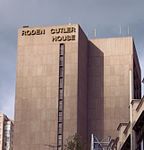Belmore Park
1868 establishments in AustraliaParks established in 1868Parks in SydneySydney central business districtUse Australian English from September 2012

Belmore Park is a public park at the southern end of the Sydney central business district in the Australian state of New South Wales. Adjacent to the Central railway station, the park is bounded by Hay Street, Eddy Avenue, Elizabeth Street and Pitt Street. The area was previously known as Police Paddock and was part of a section of Crown land which included the Police Barracks, Devonshire Street Cemetery, Female Refuge of the Good Samaritan, Benevolent Asylum and a common.
Excerpt from the Wikipedia article Belmore Park (License: CC BY-SA 3.0, Authors, Images).Belmore Park
Goold Street, Sydney Chippendale
Geographical coordinates (GPS) Address Nearby Places Show on map
Geographical coordinates (GPS)
| Latitude | Longitude |
|---|---|
| N -33.88149 ° | E 151.20769 ° |
Address
Central (Sydney Terminal)
Goold Street
2008 Sydney, Chippendale
New South Wales, Australia
Open on Google Maps









